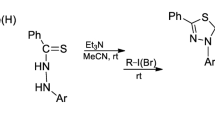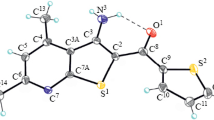Abstract
Three-component condensations of ethyl acetoacetate with 1,3-thiazol-2-amine and aromatic aldehydes in isopropyl alcohol at 20°C under ultrasonic activation lead to the formation of ethyl 5-aryl-7-methyl-5H-[1,3]thiazolo[3,2-a]pyrimidine-6-carboxylates, ethyl 5-aryl-7-hydroxy-7-methyl-6,7-dihydro-5H-[1,3]thiazolo[3,2-a]pyrimidine-6-carboxylates, or ethyl 2-hydroxy-2-methyl-2H-chromene-3-carboxylate, depending on the position and nature of substituents in the aldehyde component. The structure of the isolated compounds was determined by one- and two-dimensional NMR and IR spectroscopy, and a plausible mechanism of their formation was proposed.
Similar content being viewed by others
Avoid common mistakes on your manuscript.
Thiazolopyrimidines are heterocyclic analogs of purine bases, and they exhibit a broad spectrum of pharmacological activity [1–6], which stimulates studies of the synthesis of new compounds of this series, including potentially biologically active ones. A modern synthetic approach to thiazolopyrimidine derivatives is based on multicomponent sonochemical reactions in accordance with the “green chemistry” principles such as environmental safety, atom economy, and efficiency. Three-component syntheses of aryl-substituted thiazolopyrimidinecarboxylates, including those carried out under ultrasonic irradiation, have been reported in [7–9]. However, the effect of substituents in the aromatic ring of the aldehyde component on the reaction course was not studied.
Herein, we describe three-component condensations of aromatic aldehydes with ethyl acetoacetate and 1,3-thiazol-2-amine. The series of aldehyde components included unsubstituted benzaldehyde, 2-methyl-, 2-nitro-, 2-hydroxy-, 2-chloro-, 4-chloro-, 4-bromo-, and 3-methoxy-4-hydroxybenzaldehydes, and 2-hydroxynaphthalene-1-carbaldehyde. The reactions were carried out with equimolar amounts of the reactants in isopropyl alcohol at 20°C under ultrasonic irradiation.
The position of substituents in the initial aldehyde was the crucial factor determining the reaction direction. The reactions with benzaldehyde, 2-chloro- and 4-hydroxy-3-methoxybenzaldehydes, and 2-hydroxynaphthalene-1-carbaldehyde afforded ethyl 5-aryl-7-methyl-5H-[1,3]thiazolo[3,2-a]pyrimidine-6-carboxylates 1–4, 5-aryl-7-hydroxy-7-methyl-6,7-dihydro-5H-[1,3]thiazolo[3,2-a]pyrimidine-6-carboxylates 5–8 were obtained from 2-nitro-, 2-methyl-, 4-chloro-, and 4-bromobenzaldehydes, and ethyl 2-hydroxy-2-methyl-2H-chromene-3-carboxylate (9) was isolated in the condensation with salicylaldehyde (Scheme 1).
Compounds 1, 2, and 9 were reported previously [7–10]; the structure of the newly synthesized compounds was determined on the basis of their elemental compositions, one- and two-dimensional NMR spectra, and IR spectra.
The 1H NMR spectra of thiazolopyrimidines 1–4 showed signals of the 5-H proton (δ 6.13–6.15 ppm, s), ester ethoxy groups (δ 3.60–4.17 and 1.11–1.30 ppm for methylene and methyl protons, respectively), and 7-methyl group (δ 1.75–2.28 ppm, s). The IR spectra of 1–4 displayed absorption bands due to C=C (1650–1723 cm–1), C=N (1500–1646 cm–1), C–H (CH3, 2869–2951 cm–1), and C=O groups (1700–1790 cm–1).
In the 1H NMR spectra of 7-hydroxy analogs 5–8, the key signals were those of 5-H (δ 4.04–6.41 ppm, d), 6-H (δ 2.47–4.49 ppm, d), OH (δ 1.16–2.15 ppm, s), and CH2CH3 (δ 3.82–4.18 m and 0.90–1.13 ppm, t). In the spectra of 5 and 8, the 5-H, 6-H, OH, and OEt signals were doubled (see Experimental) due to the presence of two diastereoisomers. Molecules 5–8 possess 3 asymmetric carbon atoms (C5, C6, C7), so that the existence of 8 optically active forms and 3 racemates is possible. Protons signals of 5 were unambiguously assigned to sp3- and sp2-carbon atoms on the basis of cross peaks in the 1H–13C HSQC spectrum.
Scheme 2 shows a plausible mechanism of the formation of compounds 1–9. Initial condensation of aromatic aldehyde with ethyl acetoacetate gives α,β-unsaturated ketone A which reacts with 1,3-thiazol-2-amine to form hemiaminal B. Intramolecular cyclization of the latter involving the thiazole nitrogen atom leads to hydroxydihydrothiazolopyrimidine system 5–8; this process is favored by the presence of electron-withdrawing groups in the aldehyde moiety and steric effect of the methyl group. The formation of compounds 1–4 implies that the cyclization of B is preceded by dehydration. In the reaction with salicylaldehyde, intermediate A undergoes cyclization to form pyran ring due to spatial proximity of the hydroxy group in the ortho position of the benzene ring and carbonyl group of the acetyl fragment. Unlike salicylaldehyde, the hydroxy group in 2-hydroxynaphthalene-1-carbaldehyde is less nucleophilic because of more extended conjugation system, so that no cyclization of the corresponding intermediate A occurs.
In summary, we have synthesized new compounds of the thiazolo[3,2-a]pyrimidine series and studied the effect of the structure of the aldehyde component on the direction of their three-component condensation with ethyl acetoacetate and 1,3-thiazol-2-amine. Some of the synthesized compounds showed a pronounced cytotoxicity against HeLa cell line and are therefore promising for further studies [11].
EXPERIMENTAL
The IR spectra were recorded in KBr on an FSM 1201 spectrometer with Fourier transform (Russia). The 1H and 1H–13C HSQC spectra were recorded on a Varian spectrometer (USA) at 400 MHz for 1H using CDCl3, acetone-d6, or DMSO-d6 as solvent and tetramethylsilane as internal standard. Elemental analysis was performed with a Vario MICRO cube automatic CHNS analyzer (Germany). The melting points were measured in open capillaries. The progress of reactions was monitored by TLC on Silufol UV-254 plates using hexane–ethyl acetate–chloroform (2:2:1) as eluent; spots were visualized under UV light or by treatment with iodine vapor. The reactions were carried out using a UZV-2.8 ultrsonic bath (Russia; ultrasound power 230 W, heating power 130 W, ultrasound frequency 35 kHz).
1,3-Thiazol-2-amine (chemically pure, ethyl acetoacetate (pure), benzaldehyde (pure), 2-methylbenzaldehyde (chemically pure), 2-nitrobenzaldehyde (chemically pure), 2-hydroxybenzaldehyde (chemically pure), 2-chlorobenzaldehyde (chemically pure), 4-chlorobenzaldehyde (chemically pure), 4-bromobenzaldehyde (chemically pure), 4-hydroxy-3-methoxybenzaldehyde (chemically pure), 2-hydroxynaphthalene-1-carbaldehyde (chemically pure), and isopropyl alcohol (pure) were commercial products.
Compounds 1–9 (general procedure). Equimolar amounts of ethyl acetoacetate, aromatic aldehyde, and 1,3-thiazol-2-amine (3 mmol each) were dissolved in 3 mL of isopropyl alcohol, and the solution was subjected to ultrasonic irradiation for 120–180 min at 20°C. The solid product was filtered off, washed with isopropyl alcohol (3×20 mL), and dried in air.
Ethyl 7-methyl-5-phenyl-5H-[1,3]thiazolo[3,2-a]pyrimidine-6-carboxylate (1). Yield 0.15 g (34%), off-white crystals, mp 98–100°C [7–9].
Ethyl 5-(2-chlorophenyl)-7-methyl-5H-[1,3]thiazolo[3,2-a]pyrimidine-6-carboxylate (2). Yield 0.42 g (42%), yellow crystals, mp 105–107°C [8, 9].
Ethyl 5-(4-hydroxy-3-methoxyphenyl)-7-methyl-5H-[1,3]thiazolo[3,2-a]pyrimidine-6-carboxylate (3). Yield 0.49 g (48%), colorless crystals, mp 177–179°C. IR spectrum, ν, cm–1: 3204 (OH), 2899 (CH3), 2820 (OCH3), 1700 (C=O), 1654 (C=C), 1500 (C=N), 1594–1606 (C=Carom). 1H NMR spectrum (acetone-d6), δ, ppm: 1.14 t (3H, CH3CH2, J = 12.0 Hz), 2.28 s (3H, CH3), 2.49 s (3H, OCH3), 3.91–4.03 m (2H, CH3CH2), 6.13 s (1H, 5-H), 6.59–6.70 m (3H, Harom), 6.69 d (1H, 2-H, J = 4.0 Hz), 7.18 d (1H, 3-H, J = 4.0 Hz), 9.04 s (1H, OH). Found, %: C 58.90; H 5.61; N 8.39. C17H18N2O4S. Calculated, %: C 58.96; H 5.20; N 8.09.
Ethyl 5-(2-hydroxynaphthalen-1-yl)-7-methyl-5H-[1,3]thiazolo[3,2-a]pyrimidine-6-carboxylate (4). Yield 0.52 g (47%), brown crystals, mp 123–126°C. IR spectrum, ν, cm–1: 3210 (OH), 2899 (CH3), 1704 (C=O), 1650 (C=C), 1501 (C=N), 1595–1610 (C=Carom). 1H NMR spectrum (acetone-d6), δ, ppm: 1.30 t (3H, CH3CH2, J = 12.0 Hz), 1.75 s (3H, CH3), 3.60–3.79 m (2H, CH2CH3), 6.15 s (1H, 5-H), 6.49 d (1H, 2-H, J = 4.0 Hz), 7.10 d (1H, 3-H, J = 4.0 Hz), 6.58–7.19 m (3H, Harom), 8.00 s (1H, OH). Found, %: C 65.75; H 4.65; N 7.17. C20H18N2O3S. Calculated, %: C 65.57; H 4.92; N 7.65.
Ethyl 7-hydroxy-7-methyl-5-(2-nitrophenyl)-6,7-dihydro-5H-[1,3]thiazolo[3,2-a]pyrimidine-6-carboxylate (5). Yield 0.28 g (26%), yellow crystals, mp 127–128°C. IR spectrum, ν, cm–1: 3100 (OH), 2900 (CH3), 1700 (C=O), 1600 (C=C), 1590–1608 (C=Carom), 1550–1575 (NO2, asym.), 1230–1290 (NO2, sym.). 1H NMR spectrum (CDCl3), δ, ppm: 1.03 t and 1.13 t (3H, CH2CH3, J = 12.0 Hz), 1.16 s and 2.15 s (1H, OH), 2.44 s (3H, CH3), 4.02–4.08 m and 4.10–4.20 m (2H, CH2CH3), 4.26 d and 4.45 d (1H, 6-H, J = 8.0 Hz), 6.05 d and 6.33 d (1H, 5-H, J = 8.0 Hz), 6.45–8.08 m (6H, 2-H, 3-H, Harom). 1H/13C HSQC spectrum, δ/δC, ppm: 1.03/13.54 and 1.13/13.56 (CH2CH3/CH2CH3), 2.44/27.94 (CH3/CH3), 4.01/61.58 and 4.18/62.19 (CH2CH3/CH2CH3), 4.26/62.32, 4.45/60.29 (6-H/C6), 6.05/55.32 and 6.33/53.35 (5-H/C5). Found, %: C 52.71; H 4.92; N 11.77. C16H17N3O5S. Calculated, %: C 52.89; H 4.68; N 11.57.
Ethyl 7-hydroxy-7-methyl-5-(2-methylphenyl)-6,7-dihydro-5H-[1,3]thiazolo[3,2-a]pyrimidine-6-carboxylate (6). Yield 0.35 g (35%), off-white crystals, mp 131–132°C. IR spectrum, ν, cm–1: 3099 (OH), 2880 (CH3), 1700 (C=O), 1606 (C=C), 1600–1615 (C=Carom), 1500 (C=N). 1H NMR spectrum (acetone-d6), δ, ppm: 0.90 t (3H, CH3CH2, J = 12.0 Hz), 1.98 s (1H, OH), 2.25 s (3H, CH3), 2.47 d (1H, 6-H, J = 8.0 Hz), 3.68 s (3H, CH3C6H4), 4.04 d (1H, 5-H, J = 8.0 Hz), 3.82–3.88 m (2H, CH2CH3), 6.57–7.30 m (4H, Harom), 6.59 d (1H, 2-H, J = 4.0 Hz), 6.96 d (1H, 3-H, J = 4.0 Hz). 1H/13C HSQC spectrum, δ/δC, ppm: 0.90/13.80 (CH2CH3/CH2CH3), 2.25/29.74 (CH3/CH3), 2.47/39.90 (6-H/C6), 3.68/55.34 (CH3C6H4/CH3C6H4), 3.85/61.25 (CH2CH3/CH2CH3), 4.04/65.61 (5-H/C5). Found, %: C 61.54; H 6.10; N 8.32. C17H20N2O3S. Calculated, %: C 61.44; H 6.02; N 8.78.
Ethyl 5-(4-chlorophenyl)-7-hydroxy-7-methyl-5H-[1,3]thiazolo[3,2-a]pyrimidine-6-carboxylate (7). Yield 0.38 g (41%), yellow crystals, mp 117–119°C. IR spectrum, ν, cm–1: 2970 (CH3), 1700 (C=O), 1609 (C=C), 1599–1615 (C=Carom), 1510 (C=N). 1H NMR spectrum (acetone-d6), δ, ppm: 1.12 t (3H, CH2CH3, J = 12.0 Hz), 1.64 s (1H, OH), 2.39 s (3H, CH3), 4.01–4.13 m (2H, CH2CH3), 4.17 d (1H, 6-H, J = 4.0 Hz), 5.95 d (1H, 5-H, J = 4.0 Hz), 6.45 d (1H, 2-H, J = 4.0 Hz), 7.05 d (1H, 3-H, J = 4.0 Hz), 7.19–7.40 m (4H, Harom). 1H/13C HSQC spectrum, δ/δC, ppm: 1.12/13.39 (CH3CH2/CH3CH2), 2.39/24.41 (CH3/CH3), 4.07/61.45 (CH2CH3/CH2CH3), 4.17/61.53 (6-H/C6), 5.95/54.78 (5-H/C5). Found, %: C 54.39; H 4.48; N 8.37. C16H17ClN2O3S. Calculated, %: C 54.47; H 4.82; N 7.94.
Ethyl 5-(4-bromophenyl)-7-hydroxy-7-methyl-5H-[1,3]thiazolo[3,2-a]pyrimidine-6-carboxylate (8). Yield 0.37 g (43%), brown crystals, mp 125–127°C. IR spectrum, ν, cm–1: 2935 (CH3), 1712 (C=O), 1622 (C=C), 1589–1604 (C=Carom), 1499 (C=N). 1H NMR spectrum (CDCl3), δ, ppm: 1.13 t (3H, CH2CH3, J = 12.0 Hz), 1.67 s and 2.30 s (1H, OH), 2.18 s (3H, CH3), 3.94 d and 4.04 d (1H, 6-H, J = 8.0 Hz), 4.02–4.07 m and 4.09–4.14 m (2H, CH2CH3), 5.41 d and 5.56 d (1H, 5-H, J = 12.0 Hz), 6.48 d (1H, 2-H), 6.79–7.44 m (4H, Harom), 7.07 d (1H, 3-H, J = 4.0 Hz). Found, %: C 48.65; H 3.95; N 7.38. C16H17BrN2O3S. Calculated, %: C 48.36; H 4.28; N 7.05.
Ethyl 2-hydroxy-2-methyl-2H-chromene-3-carboxylate (9). Yield 0.08 g (22%), colorless crystals, mp 111–113°C [10].
REFERENCES
Hawas, U.W., Al-Omar, M.A., Amr, A.G.E., and Hammam, A.El-F.G., Arab. J. Chem., 2012, vol. 5, p. 509. https://doi.org/10.1016/j.arabjc.2010.09.019
Duval, R., Kolb, S., Braud, E., and Genest, C., J. Comb. Chem., 2009, vol. 11, p. 947. https://doi.org/10.1021/cc900140f
Moty, S.G.A., Hussein, M.A., Aziz, S.A.A., and Abou-Salim, M.A., Saudi Pharm. J., 2016, vol. 24, p. 119. https://doi.org/10.1016/j.jsps.2013.12.016
Youssef, M.M. and Amin, M.A., Molecules, 2012, vol. 17, p. 9652. https://doi.org/10.3390/molecules17089652
Hassan, G.S., El-Messery, S.M., and Abbas, A., Bioorg. Chem., 2017, vol. 74, p. 41. https://doi.org/10.1016/j.bioorg.2017.07.008
Khalilpour, A., Asghari, S., and Pourshab, M., Chem. Biodiversity, 2019, vol. 16, no. 5, article ID e1800563. https://doi.org/10.1002/cbdv.201800563
Batool, I., Saeed, A., Qureshi, I., Kalsoom, S., and Razzaq, A., Res. Chem. Intermed., 2016, vol. 42, p. 1139. https://doi.org/10.1007/s11164-015-2078-2
Tan, S.H., Chuah, T.S., and Chia, P.W., J. Korean Chem. Soc., 2016, vol. 60, p. 245. https://doi.org/10.5012/jkcs.2016.60.4.245
Meshram, H.M., Sanjeeva Kumar, A., Santosh Kumar, G., Swetha, A., Chennakesava Reddy, B., and Ramesh, P., Pharma Chem., 2012, vol. 4, p. 956.
Dai, L.Z., Shi, Y. L., Zhao, G.L., and Shi, M., Chem. Eur. J., 2007, vol. 13, p. 3701. https://doi.org/10.1002/chem.200601033
Vasil’eva, E.S., Burygin, G.L., and Kriven’ko, A.P., Materialy III Vserossiiskoi molodezhnoi konferentsii “Problemy i dostizheniya khimii kislorod- i azotsoderzhashchikh biologicheski aktivnykh soedinenii” (Proc. IIIrd All-Russian Youth Conf. “Problems and Advances in the Chemistry of Oxygen- and Nitrogen-Containing Biologically Active Compounds”), Ufa, 2018, p. 25.
Author information
Authors and Affiliations
Corresponding author
Ethics declarations
The authors declare no conflict of interest.
Rights and permissions
About this article
Cite this article
Vasilkova, N.O., Nikulin, A.V. & Krivenko, A.P. Synthesis and Structure of Thiazolopyrimidine Derivatives. Russ J Org Chem 56, 990–993 (2020). https://doi.org/10.1134/S1070428020060044
Received:
Revised:
Accepted:
Published:
Issue Date:
DOI: https://doi.org/10.1134/S1070428020060044






